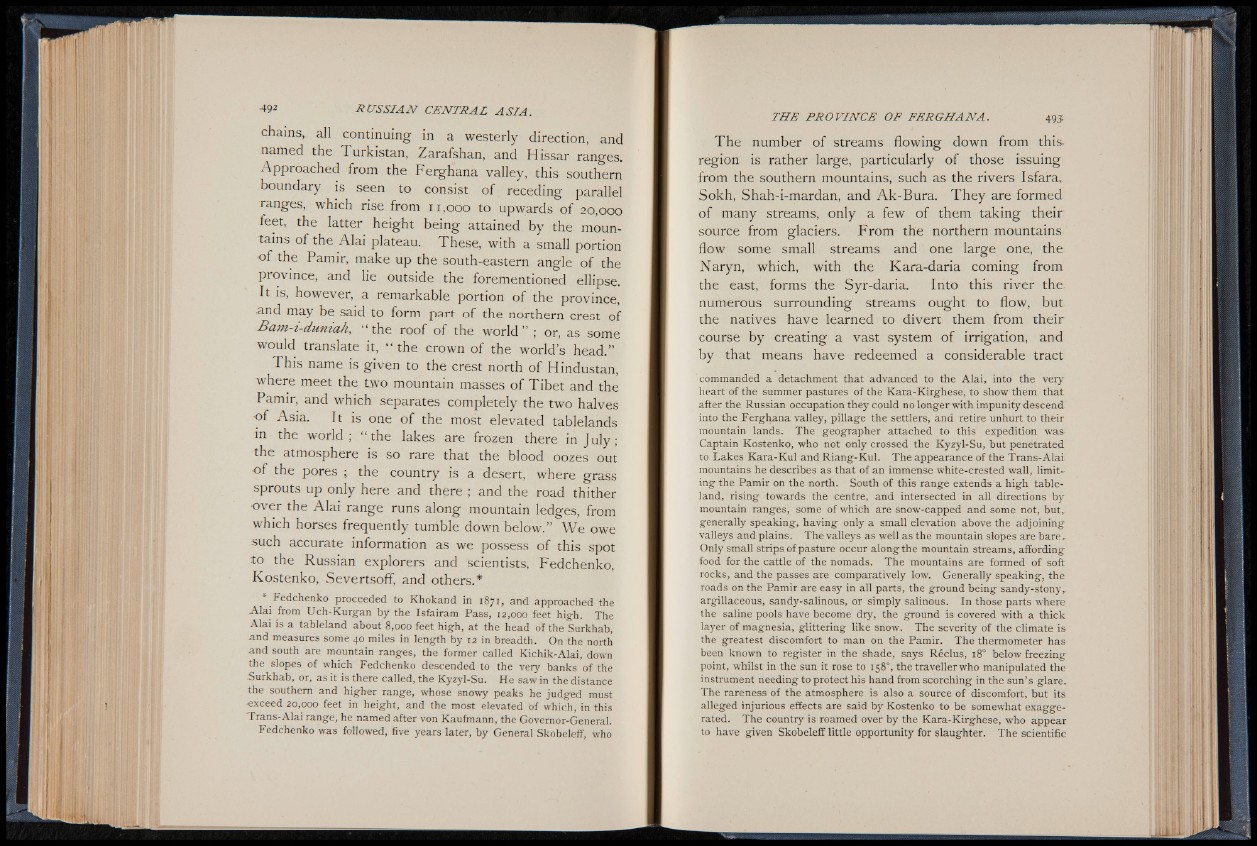
chains, all continuing in a westerly direction, and
named the Turkistan, Zarafshan, and Hissar ranges.
Approached from the Ferghana valley, this southern
boundary is seen to consist of receding parallel
ranges, which rise from 11,000 to upw;ards of 20,000
feet, the latter height being attained by the mountains
o f the Alai plateau. These, with a small portion
o f the Pamir, make up the south-eastern angle of the
province, and lie outside the forementioned ellipse.
It is, however, a remarkable portion of the province,
and may be said to form part of the northern crest of
Bam-i-dumah, “ the roof of the world ” ; or, as some
would translate it, “ the crown of the world’s head.”
This name is given to the crest north of Hindustan,
where meet the two mountain masses of Tibet and the
Pamir, and which separates completely the two halves
■of Asia. It is one of the most elevated tablelands
in the world; “ the lakes are frozen there in July;
the atmosphere is so rare that the blood oozes out
•of the pores ; the country is a desert, where grass
sprouts up only here and there ; and the road thither
over the Alai range runs along mountain ledges, from
which horses frequently tumble down below.” We owe
such accurate information as we possess of this spot
to the Russian explorers and scientists, Fedchenko,
Kostenko, Severtsoff, and others.*
* Fedchenko proceeded to Khokand in 1871, and approached the
A la i from Uch-Kurgan by the Isfairam Pass, 12,000 feet high. The
A lai is a tableland about 8,000 feet high, at the head of the Surkhab,
and measures some 40 miles in length by 12 in breadth. On the north
and south are mountain ranges, the former called Kichik-Alai, down
the slopes of which Fedchenko descended to the very banks of the
Surkhab, or, as it is there called, the Kyzyl-Su. He saw in the distance
the southern and higher range, whose snowy peaks he judged must
■exceed 20,000 feet in height, and the most elevated bf which, in this
Trans-A lai range, he named after von Kaufmann, the Governor-General.
Fedchenko was followed, five years later, by General Skobeleff, who
The number of streams flowing down from this
region is rather large, particularly of those issuing
from the southern mountains, such as the rivers Isfara,,
Sokh, Shah-i-mardan, and Ak-Bura. They are formed
of many streams, only a few of them taking their
source from glaciers. From the northern mountains
flow some small streams and one large one, the
Naryn, which, with the Kara-daria coming from
the east, forms the Syr-daria. Into this river the
numerous surrounding streams ought to flow, but
the natives have learned to divert them from their
course by creating a vast system of irrigation, and
by that means have redeemed a considerable tract
commanded a detachment that advanced to the A lai, into the very
heart of the summer pastures of the Kara-Kirghese, to show them that
after the Russian occupation they could no longer with impunity descend
into the Ferghana valley, pillage the settlers, and retire unhurt to th'eir
mountain lands. The geographer attached to this expedition was-
Captain Kostenko, who not only crossed the Kyzyl-Su, but penetrated
to Lakes Kara-Kul and R iang-Kul. The appearance of the Trans-Alai
mountains he describes as that of an immense white-crested wall, limiting
the Pamir on the north. South of this range extends a high tableland,
rising towards the centre, and intersected in all directions by
mountain ranges, some of which are snow-capped and some not, but,,
generally speaking, having only a small elevation above the adjoining
valleys and plains. The valleys as well as the mountain slopes are bare .
Only small strips o f pasture occur along the mountain streams, affording
food for the cattle of the nomads. The mountains are formed of soft
rocks, and the passes are comparatively low. Generally speaking, the
roads on the Pamir are easy in all parts, the ground being sandy-stony,,
argillaceous, sandy-salinous, or simply salinous. In those parts where
the saline pools have become dry, the ground is covered with a thick
layer of magnesia, glittering like snow. The severity of the climate is
the greatest discomfort to man on the Pamir. The thermometer h a s
been known to register in the shade, says R6clus, 18° below freezing
point, whilst in the sun it rose to 158°, the traveller who manipulated the
instrument needing to protect his hand from scorching in the sun’ s glare.
The rareness of the atmosphere is also a source of discomfort, but its
alleged injurious effects are said by Kostenko to be somewhat exa gg e rated.
The country is roamed over by the Kara-Kirghese, who appear
to have given Skobeleff little opportunity for slaughter. The scientific